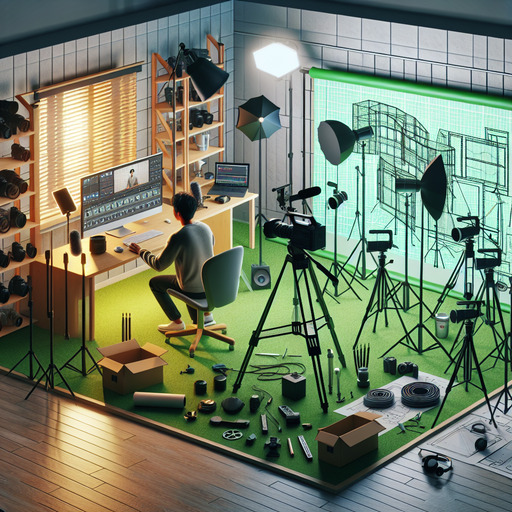
-
Table of Contents
Ready to create your own video production studio at home? Discover the ultimate guide now! Start building your studio today!
Introduction
Creating a video production studio at home has become increasingly accessible and essential for content creators, educators, and professionals alike. “A Guide to Building a Video Production Studio at Home” provides a comprehensive roadmap to transform any space into a functional and efficient studio. This guide covers everything from selecting the right equipment, optimizing lighting and sound, to setting up a conducive environment for filming. Whether you’re a beginner or looking to upgrade your current setup, this guide offers practical tips and insights to help you produce high-quality videos from the comfort of your home.
A Guide to Building a Video Production Studio at Home: Essential Tips for Professional Videography Services
Creating a video production studio at home can be a transformative step for anyone looking to offer professional videography services. Whether you are a seasoned videographer or a budding enthusiast, having a dedicated space equipped with the right tools can significantly enhance the quality of your work. To begin with, selecting the appropriate space is crucial. Ideally, you should choose a room that is quiet, has minimal natural light interference, and offers enough space to accommodate your equipment and movement. A basement or a spare room can often serve as an excellent starting point.
Once you have identified the space, the next step is to focus on soundproofing. Sound quality is paramount in video production, and external noises can be a major distraction. To mitigate this, consider installing acoustic panels on the walls and ceiling. These panels help to absorb sound and reduce echo, ensuring that your audio recordings are crisp and clear. Additionally, using heavy curtains or carpets can further dampen any residual noise.
Lighting is another critical aspect that can make or break the quality of your videos. Natural light can be unpredictable, so investing in artificial lighting solutions is advisable. Softbox lights, ring lights, and LED panels are popular choices among videographers. These lights provide consistent and adjustable illumination, allowing you to control the mood and tone of your videos. Positioning the lights correctly is equally important; a three-point lighting setup, which includes a key light, fill light, and backlight, is a standard approach that helps to eliminate shadows and highlight the subject effectively.
Equipping your studio with the right camera and audio gear is essential for producing professional-grade videos. While there are numerous options available, it is important to choose equipment that suits your specific needs and budget. A high-definition camera with manual settings will give you greater control over your shots. Additionally, investing in a good quality microphone, such as a shotgun or lavalier mic, can significantly improve your audio quality. Don’t forget to include a sturdy tripod to keep your camera steady and avoid shaky footage.
Editing is an integral part of the video production process, and having a powerful computer with the right software is indispensable. Programs like Adobe Premiere Pro, Final Cut Pro, and DaVinci Resolve offer a range of features that can help you edit your videos with precision. Ensure that your computer has sufficient processing power, RAM, and storage to handle large video files and complex editing tasks. A dual-monitor setup can also enhance your workflow by providing more screen real estate for your editing tools and timelines.
In addition to the core equipment, there are several accessories that can enhance your studio’s functionality. Green screens, for instance, allow you to create various backgrounds and special effects. External hard drives are useful for backing up your footage and freeing up space on your primary storage. Cable management solutions, such as clips and sleeves, can help keep your workspace organized and clutter-free.
Finally, it is important to continually educate yourself and stay updated with the latest trends and technologies in videography. Online tutorials, workshops, and industry forums can provide valuable insights and tips to refine your skills. Building a video production studio at home is an ongoing process that requires dedication and a willingness to adapt. By carefully planning and investing in the right equipment, you can create a professional environment that elevates the quality of your videography services and sets you apart in a competitive market.
Q&A
1. **What are the essential components needed to build a video production studio at home?**
– **Camera:** A high-quality DSLR, mirrorless camera, or a professional video camera.
– **Microphone:** A good quality external microphone, such as a shotgun mic, lavalier mic, or a condenser mic.
– **Lighting:** Softbox lights, ring lights, or LED panels to ensure proper lighting.
– **Tripod/Stabilizer:** A sturdy tripod or a gimbal for stable shots.
– **Backdrop:** Green screen or other backdrops for different settings.
– **Computer:** A powerful computer with good processing power and sufficient RAM.
– **Editing Software:** Professional video editing software like Adobe Premiere Pro, Final Cut Pro, or DaVinci Resolve.
– **Audio Interface:** For connecting professional microphones to your computer.
– **Cables and Accessories:** Necessary cables, adapters, and other accessories.
– **Soundproofing:** Acoustic panels or foam to reduce echo and outside noise.